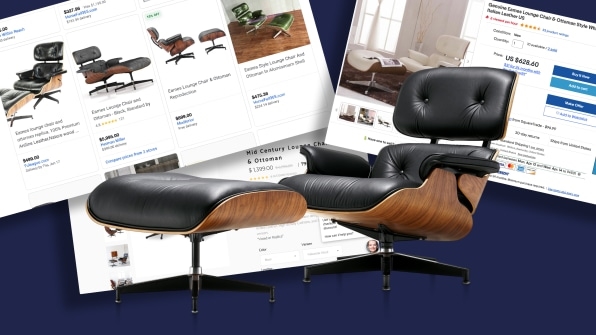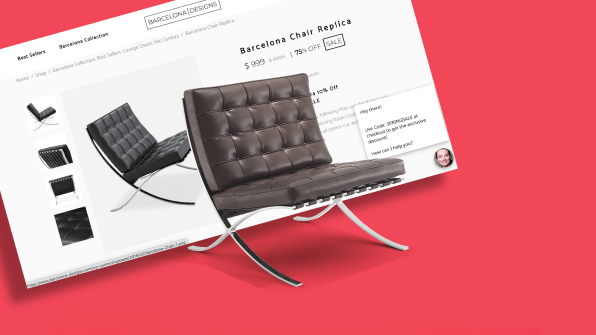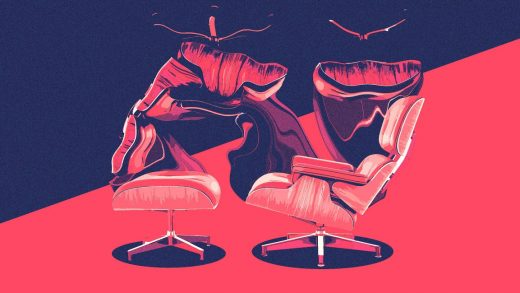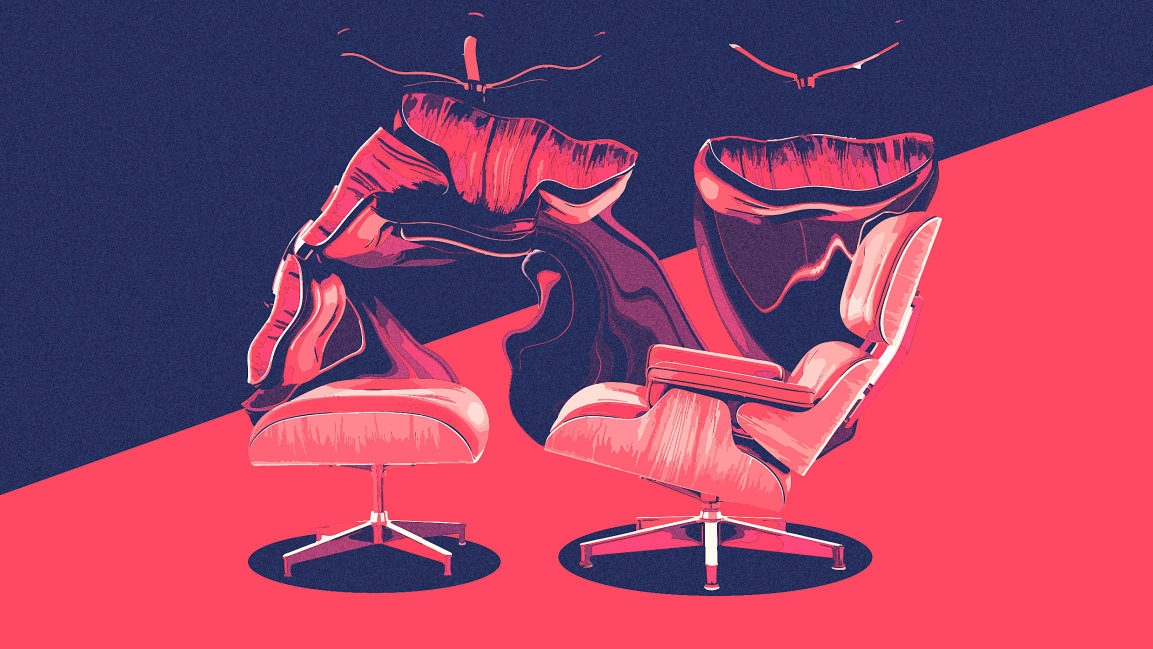The $4 billion problem designers can’t shake
The Eames lounge chair and ottoman are icons of mid-century American design. With a curved plywood back and playfully tufted upholstery, they look as fresh in 2021 as they did when they debuted 65 years ago.
They are also relentlessly copied. Search eBay, and dozens of fakes appear. Sometimes the product descriptions are modified and misspelled to avoid explicitly misleading consumers (“Eams Style”). Other times, they outright lie and say the furniture is genuine. On Google Shopping, more than half of the top hits are replicas. The biggest giveaway is the price: The original costs $5,500 and up. Fakes usually cost $600 to $1,200. Cheaper but not exactly cheap.

The Eames lounge chair is one of hundreds, if not thousands, of designs counterfeited then sold to consumers. The rise of e-commerce has made it exceedingly easy for knockoff artists to sell replicas of popular furniture at a fraction of the original cost. Designers and manufacturers have some legal recourse, but not much. Many describe the process of combating knockoffs as a game of whack a mole: As soon as you shut down one company, another pops up.
To fight back, designers are banding together under a nonprofit organization called Be Original Americas. Founded by PR maven and former Metropolis magazine publisher Beth Dickstein in 2012, Be Original Americas has 126 paid members who vow not to support fakes. They range from major American companies (Design Within Reach, Herman Miller, Steelcase) to European brands (Fritz Hansen, Artemide, Moooi) to prestigious mid-size design studios (MNML, Bruce Mau Design, Fuseproject). Architects, including Studio O + A and Gensler, the world’s largest architecture firm, have joined, too.
The organization’s mandate is simple: to protect designers’ intellectual property both by educating the public about the value of authentic design and by purging the market of fakes. Over several years, Be Original Americas has helped U.S. Customs and Border Protection seize nearly 18,000 pieces of knockoff furniture worth an estimated $30.3 million if the goods were genuine. “Original design is sacrosanct. People should be paid for it,” says Kenneth Baker, a managing principal at Gensler, who showed up to our Zoom interview dressed marvelously in head-to-toe Gucci. “Be Original Americas gives a bigger voice to this movement of keeping original. Using plagiarized [design]? It’s kind of like embezzlement.”
That might sound like an overstatement, but for designers and manufacturers, the stakes couldn’t be higher, especially during a year when furniture sales skyrocketed. Counterfeit pieces abound on small, generic furniture sites in addition to major platforms like eBay, Amazon, and Alibaba. One design retailer estimates that knockoffs put a $4 billion dent in the luxury furniture business each year.
For consumers, the argument for buying original design is tough in a retail climate that favors cheap, disposable goods and free, two-day shipping. But sentiment might be shifting. Homebound for a year, many of us have been forced to look closely at how we fill our domestic spaces and consider the real cost of all our flimsy plastic chairs and $30 bookcases. While sales of furniture rose 12% overall during the pandemic, sales at some companies that stock original design exclusively rose even more. The French luxury furniture brand Ligne Roset reported a 40% increase year over year. At Minneapolis-based Blu Dot, which produces mid-range modern furniture, online sales climbed 50%. This suggests that consumers may be coming around to the notion that authentic design is a worthy investment—for their homes and the planet.
“Legal chicken”
One major challenge facing designers is that knockoffs aren’t categorically illegal in the United States. Some are legal, others are not. It all depends on the protections designers seek for their work.
Broadly speaking, U.S. law actually enables copycats. Designers can secure patents and copyrights, but those offer a limited period of exclusivity—for a patent, it’s 15 years. Then the design belongs to the public and anyone can copy it. “The status quo is there is nothing wrong with copying another company’s product,” says Sarah Burstein, an expert in design patents and a professor at the University of Oklahoma. “Free competition is the baseline in the U.S.”
Some companies have found a workaround by getting their designs protected under trademark law. Trademark rights can last forever as long as a company keeps selling a product. But trademarks are tricky. They’re meant to prevent consumers from being confused about a product’s origins (courts don’t want a customer to think he’s buying Herman Miller when he’s not). They’re not available for designs that are considered functional, like a table—only the shape of a table can receive trademark protection. So while prominent retailers including Herman Miller, which sells authentic Eames furniture, have aggressively sought trademarks for their products, others have failed to secure that protection, or never went after it in the first place. Without securing a valid trademark, patent, or copyright—or all three—designers all but roll out the red carpet for others to steal their work.
Even with legal protections, designers and manufacturers say they still battle fakes all the time. That’s because there are more counterfeits than a company can catch at any given time. “We spend hundreds of thousands of dollars defending our designs each year,” says John Christakos, cofounder of Blu Dot. “When we discover someone has knocked us off, we always start with a friendly letter, CEO to CEO, and give them the benefit of the doubt. We’ll say, ‘I’m sure some factory or supplier offered you this [design] and claimed it’s their own, and I’m telling you it’s not theirs, it’s ours.’ That works more than 50% of the time. When that doesn’t work, you sue them. It becomes a game of legal chicken.”
Christakos sees these legal crusades as a necessary, if not particularly welcome, cost of doing business. “We go to town any time anyone knocks us off. If we don’t, it just opens the door [to more knockoffs],” he says. “We are a company founded by designers, and we design everything we make. That’s our lifeblood, our creative product.”
But not all designers have the means, or the patience, to sic lawyers on a seemingly endless parade of copycats. And even those who do can’t unearth every knockoff. That’s where Be Original Americas provides a different kind of defense.
Be Original Americas at the border
Each year, U.S. Customs and Border Protection seizes an estimated $1.5 billion of counterfeit goods at American ports. (That figure dipped slightly to $1.3 billion in 2020, as imports overall fell during the pandemic.) These goods predominantly originate in Hong Kong and China, and they include everything from watches to handbags to, yes, furniture. Knockoff mid-century modern furniture, in particular, has seen explosive growth over the past several years, with seizures worth $34 million between 2016 and 2020. The Eames lounge chair and ottoman (which have trademark protections) are counterfeited all the time. So too are Isamu Noguchi’s sculptural coffee table and Emeco’s aluminum Navy chair, which is said to be modeled off the rear of actress Betty Grable. After the goods are confiscated, they’re destroyed.
Be Original Americas helps Customs identify shipments of fake goods by sending tips about suspected counterfeiters through an “allegations portal.” The tips are analyzed along with other intelligence and, if reliable, passed along to Customs field agents who inspect imports at U.S. ports. Through this process, Be Original Americas member Ligne Roset was able to prevent $1.5 million in knockoffs of its classic Togo sofa from entering the United States.
Be Original Americas members also teach field agents what to look for in knockoffs, like materials, colors, and quality issues that aren’t features of an original design. For instance, Hans Wegner’s Wishbone Chair, a common target of plagiarizers, has a backrest crafted from a single piece of curved wood, which gives the chair its elegant form and stability. Knockoffs typically make the backrest from three separate parts. “This partnership and collaboration with BOA has been absolutely invaluable in helping us stay abreast of counterfeiting trends,” says Lisa Fong, international trade specialist at U.S. Customs and Border Protection.
A design education
Fighting fakes on the supply side is only part of the battle. Equally important is reducing consumer demand, says BOA founder Beth Dickstein—arguably a much more difficult task. After all, counterfeiters are just giving people what they want: the look of an expensive chair without the expense.
Be Original Americas has a couple strategies. First, it has annual student fellowships to train the next generation of designers and business leaders about the value of authentic design. “Even within our industry, it’s not necessarily taught at the universities anymore: How original design can be distinguished and who the designer was behind it,” says Simone Vingerhoets, executive vice president of Ligne Roset North America. Last year’s fellowship took place virtually and attracted more than 3,400 students from 33 countries. Sessions included everything from a webinar on how the famed British manufacturer Anglepoise developed a spring that reinvented lighting in 1932 to an exclusive tour of the Danish silversmith Georg Jensen.
Be Original Americas also opens membership to designers and manufacturers of all stripes, including architecture firms. Architects may not be the most obvious advocates of designer furniture. But many architects actually design furniture themselves. More importantly, many architects spec furniture for their clients—and a lot of it. Think about the number of chairs and tables that go into a new office space for a large tech company. Now multiply that by hundreds or even thousands for a big firm like Gensler, which has more than 3,500 clients and does $1.55 billion in billings each year. Not a single project uses knockoffs. “Even prior to Be Original Americas, we had a policy of no knockoffs,” says Gensler’s Kenneth Baker. “We’ll say in a design presentation [to clients], ‘If you can’t afford the fur coat, buy a wool coat. Don’t buy the fake fur.’ The firms that I’m working with are on board. They want their design to represent their brand. It’s a brand statement that they’re not plagiarizing.”
The bigger challenge is educating general consumers. How do you persuade cost-conscious buyers to invest in authentic design when they can snag something similar-looking for less than half the price? I took an informal survey on Twitter to gather stories about who buys knockoffs and why. One person said he couldn’t rationalize spending more than $5,000 on an original Eames lounge chair because he has small children, and they would destroy it. Another told me he owns several of Herman Miller’s Aeron chairs, the O.G. ergonomic work chair designed by Bill Stumpf and Don Chadwick in 1994, because he sees them as an investment in his health, and knockoffs don’t match the quality. But he has no problem buying counterfeit accent chairs, including Mies van der Rohe’s Modernist masterpiece, the Barcelona Chair, which retails for an eye-popping $6,500. “The Barcelona Chair was made in 1929 and the patents have long expired,” he says. “I like the look, but couldn’t justify paying for the original especially with my dogs and daughter. We got [the replicas] from Costco.”

Other respondents were more conflicted. One woman who works for the prominent retailer Knoll shared that she owns a knockoff Saarinen table (something she is too embarrassed to admit to coworkers). But it hasn’t held up terribly well. “The quality is not great,” she says. “It has a wobble and some lacquer chipped off. I just got a real Saarinen side table and the quality of that piece really puts the knockoff to shame. This experience has taught me to stick to my usual standard: Buy designer if you can afford it, but go Ikea if you can’t. There really is no middle ground.”
Her story reflects a common refrain among Be Original Americas members: If you can’t buy the real thing, buy something else. Don’t buy a fake. Plenty of companies sell inexpensive, original design, Ikea chief among them. The rise of direct-to-consumer furniture brands, like Floyd and Burrow, has introduced even more affordable options. “Our mission from the get go was to make design more democratic and accessible,” says Christakos of Blu Dot, which sells chairs for as little as $199 and desks for $499. “We don’t charge an exorbitant amount. We make enough to pay everyone and keep the lights on.” Knockoffs threaten that business. “There are so many ideas in the world,” he says. “Why steal ours?”
Sustainability first
Perhaps the most compelling argument that BOA and its members put forth is the notion that an investment in authentic design is an investment in the health of the planet. Designer furniture won’t fall apart. It can be passed down through generations. It won’t fester in a landfill, because who would throw out a $6,000 chair? According to a recent consumer survey by IBM and the National Retail Federation, nearly eight in 10 respondents said sustainability is important to them, and almost six in 10 said they are willing to change their shopping habits to curb their environmental footprint. COVID-19 has no doubt accelerated the trend, as many people stuck at home have had to literally sit with the consequences of their purchasing decisions. “COVID is forcing people to think about sustainability,” says BOA’s Dickstein. “They’re sitting in a [counterfeited] chair and it breaks and they have to throw it in a landfill? They don’t want to do that.”
Ben Watson, chief creative officer at Herman Miller, echoes the sentiment. “The general societal trend is in our favor, pandemic aside, as our culture embraces stewardship of the planet and buying sustainable as opposed to throwaway products,” he says. “We’re feeling it in our businesses. More consumers want to buy less but better.” Sales at Herman Miller and its sibling companies Design Within Reach and Hay grew 42% over the previous year, with the most significant gains in home office furniture, outdoor furniture, and big-ticket comfort items like, you guessed it, the Eames lounge chair.

Of course, just because something is built to last doesn’t mean it’s always gentle on the environment. Plenty of designers and design companies make furniture using toxic chemicals and unsustainable materials, like virgin plastic. But as pressure mounts on companies of all kinds to slash their carbon emissions, furniture brands will have to innovate—and that’s exactly where counterfeiters can’t compete. Kartell, an Italian brand renowned for plastic furniture and lighting, has started making its famous Componibili storage table out of bioplastic. The bio-version is now a best seller at MoMA Design Store. Kartell is also researching plant-based polycarbonate alternatives for its Bourgie Lamp by Memphis designer Ferruccio Laviani.
All these advances require significant capital and labor—which is why Be Original Americas describes knockoffs as “not just the theft of an idea, but the theft of opportunity.” “It’s a core thesis of Be Original Americas that investments in originality make possible further investments and new design and new innovations,” Watson says. “I get super geeked out about the kinds of innovations that some of our teams are working on, like desks that are made from fabric scraps. Projects like that take years of R&D. But we have to do a better job of getting those stories out. That’s one of the challenges facing not just Herman Miller but all makers who are investing in innovation: Building the awareness and [conveying] the value of that work.”
(27)



